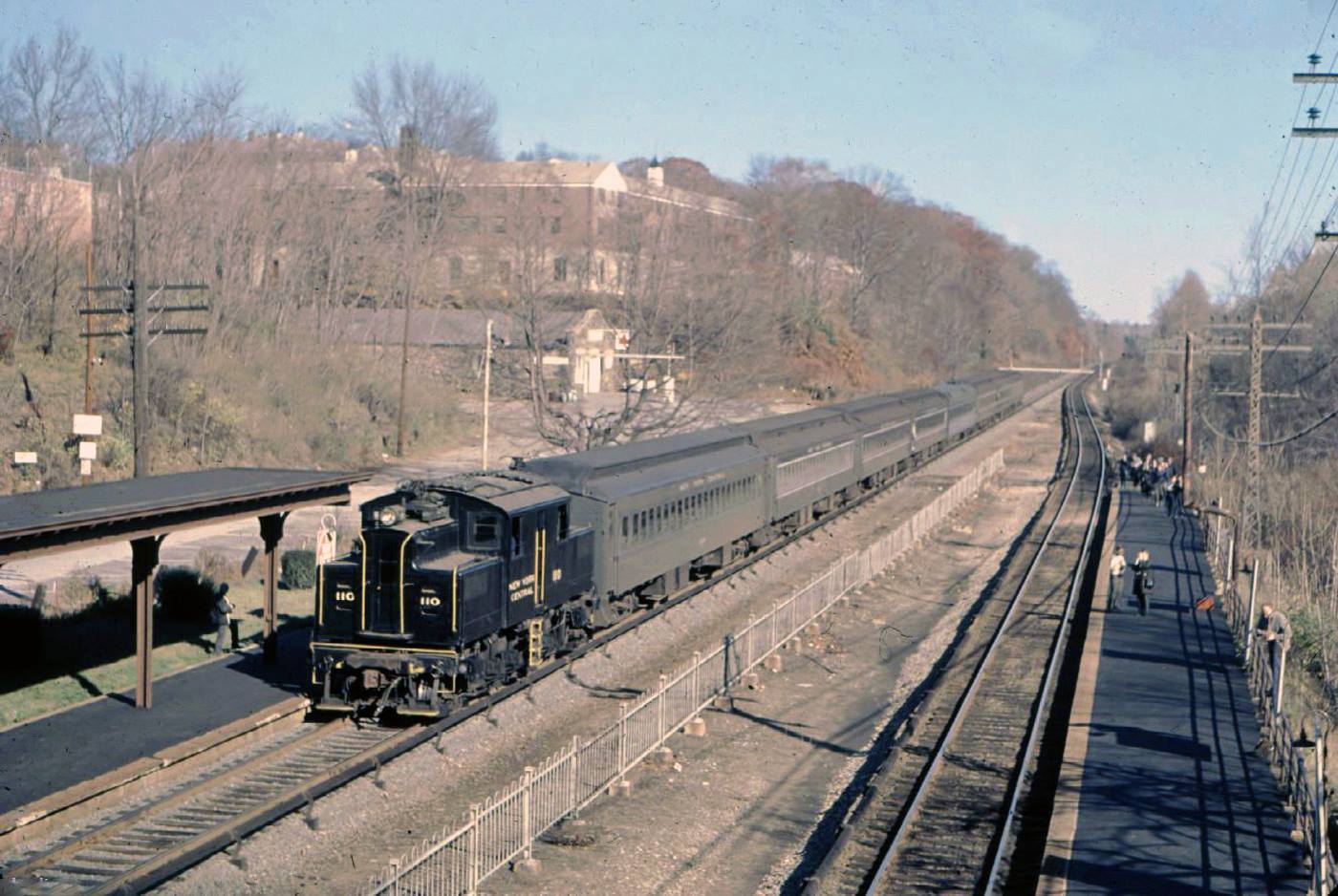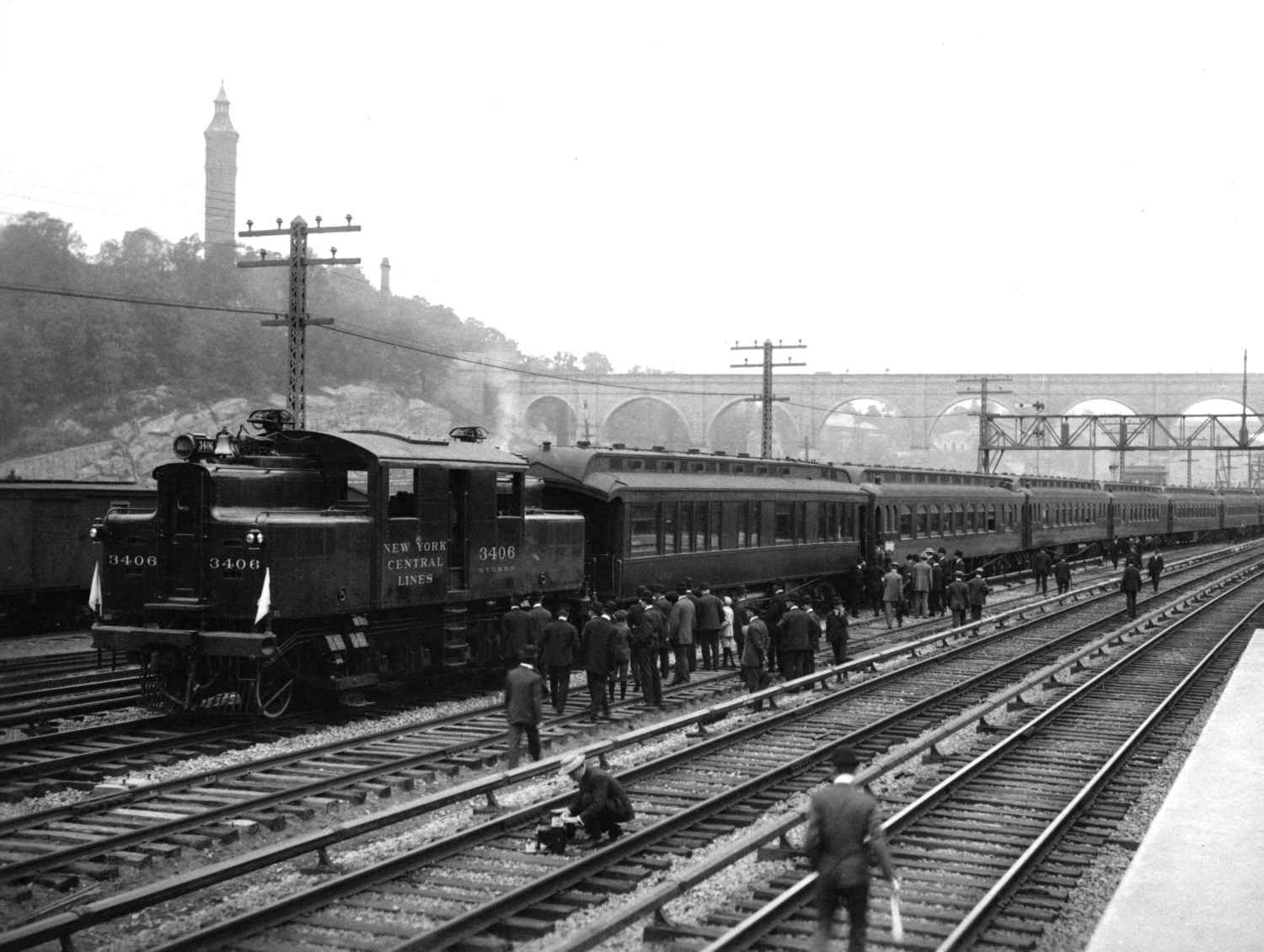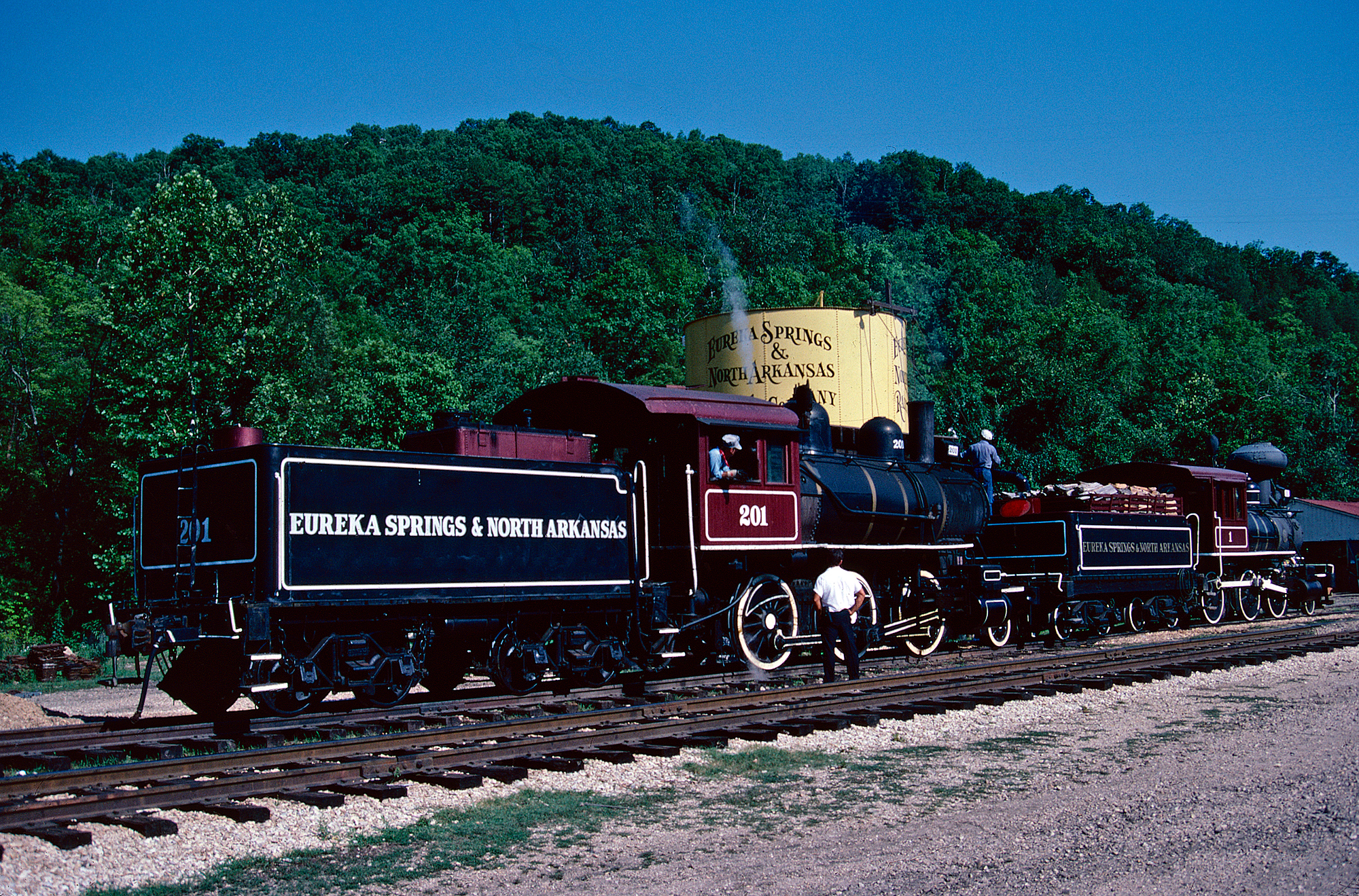NYC's 'S-Motor' Electric Locomotives: Specs, Roster, Photos
Last revised: November 2, 2024
By: Adam Burns
The S-Motor is a type of electric locomotive that was used by the New York Central Railroad. Built by General Electric and the American Locomotive Company, the S-Motor was introduced in the early 20th century.
The S-Motors were the first mass produced in the United States with #6000's (later renumbered 100) completion in 1904. The locomotives utilized NYC's third-rail system used throughout the New York City region. They were rugged, hearty engines that remained in service well into the Penn Central era.
 New York Central Class S-2 motor #110 heads a fan trip at Hartsdale, New York during November of 1966. These electrics, products of Alco and General Electric during the first decade of the 20th century, saw many years of regular service. Today, three S Motors are known to survive including the prototype, #100.
New York Central Class S-2 motor #110 heads a fan trip at Hartsdale, New York during November of 1966. These electrics, products of Alco and General Electric during the first decade of the 20th century, saw many years of regular service. Today, three S Motors are known to survive including the prototype, #100.History
The S-Motor electric locomotives hold a distinct and vital place in the annals of railway history. Operated by the New York Central (NYC), these locomotives are emblematic of the shift towards efficient, electrically-powered rail operations at the turn of the 20th century.
Serving the bustling New York metropolitan area, the S-Motors were primarily deployed in passenger and commuter operations, serving NYC's electrification throughout the New York City region.
They were used, most notably, in and around the iconic Grand Central Terminal, there fulfilling a role both practical and symbolic in ensuring the smooth transit of countless passengers daily.
Renowned companies such as General Electric and the American Locomotive Company were responsible for the manufacturing of the S-Motors. The collaboration of these manufacturing heavyweights resulted in locomotives that were both efficient and ahead of their time.
NYC Electrification
New York Central's electrification of its New York City lines initially began as an idea in the late 19th century to solve the ever-growing congestion issue of passenger traffic using its main line into downtown Manhattan to reach the railroad’s Grand Central Depot.
To solve this increasing problem the NYC decided to construct a series of underground tunnels and reach Manhattan via a much larger, and brand new terminal.
Due to the tunnels' length the railroad realized the only practical type of motive power to serve such an undergroudn labyrinth of trackage was electrics.
The development of this project was swiftly expedited after a New York Central passenger train collided with a New York, New Haven & Hartford suburban train in January of 1902 in New York City due a smoke-obscured signal.
The aftermath of this accident soon led to cities passing ordinances banning steam from within urban limits due to their inherent health and safety risks.
New York City required the discontinuance of steam locomotives by July 1, 1908. In response, the New York Central quickly began electrifying its lines in and around the city. They officially opend for service on September 20, 1906.
In total, the New York Central electrified its Hudson Division between the later built Grand Central Terminal and Harmon (now Croton-Harmon) as well as its Harlem Division.
The NYC's electrification featured a 660-volt, direct current (DC) system employing third-rail, similar to the Baltimore & Ohio's project along its Baltimore Belt Railroad project a decade earlier.
Prototype 6000
The NYC's first electric was 6000, a collaboration between Alco and GE with the former building the engine itself and the latter providing electrical equipment.
Listed as Class L it featured a 1-D-1 wheel arrangement and four gearless "bi-polar" traction motors (at 550 horsepower each), utilized in the axle shaft as the motor armature. It was a compact, 39 feet in length and could operate in either direction.
The locomotive acquired its electricity via a unique mode of power delivery. Rather than traditional overhead lines, they utilized a unique third-rail shoe method to collect electricity. This system reduced their overall height, making them ideal for use in tunnel-heavy routes.
Between October, 1904 and July, 1906 #6000 racked up 50,000 miles testing at both Alco and GE in Schenectady, New York. With the advantages the locomotive offered it is surprising more railroads did not adopt electrification in spite of its cost.
Specifications
| Entered Production | 1904 (#6000) |
| Years Produced | 1904-1909 |
| Weight | 228,000 Lbs (S-1, S-2): 224,000 Lbs (S-2a): 242,000 Lbs (S-3) |
| Wheel Arrangement | 1-D-1/2-D-2 |
| Length | 39' 0" (S-1, S-2): 37' 0" (S-2a): 43' 2" (S-3) |
| Electrical System | 660-volt DC, Third Rail |
| Maximum Speed | 60 mph |
| Traction Motors | GE (4) @ 550 hp |
| Horsepower | 2,200 (starting): 1,695 (continuous) |
| Tractive Effort | 37,000 Lbs (continuous) |
Roster
| Class | 1st Road Number | 2nd Road Number Series | 3rd Road Number Series | Completion Date |
|---|---|---|---|---|
| L/T-1/S-1 | 6000 | 3400 | 100 | 10/1904 |
| T-2/S-2 | 3401-3434 | 101-134 | - | 1906 |
| S-3 | 135-146 | 1100 Series | - | 1908-1909 |
The motor could provide much more power than a standard steam locomotive - especially accelerating and handling a consist upgrade - but yet was half the length and weighed, roughly, 30% less.
Installation of third rails inside the terminal area and approach tunnels was a challenging task. Still, it paved the way for the smooth operation of the S-Motors and demonstrated the forward-thinking nature of the NYC and its commitment to embrace the future.
There were still gaps, however, in the electricity at slip switchs and crossovers. To remedy this issue the NYC imployed short sections of overhead catenary where appropriate and the locomotives featured small rooftop pantographs to capture this "juice."
Operation
When delivered to the NYC, 6000 was renumbered 3400 and given class T-1. Unfortunately, just two days after entering service in 1907 it was involved in a serious accident in the Bronx that killed 23 people and injured dozens more.
The railroad re-evaluated the design and decided the addition of an axle fore and aft would provide greater stability and eliminate potential derailments in curves. As a result, the original Class T-1 example, and 34 additional T-2s, were rebuilt with a 2-D-2 wheel arrangement.
Following this modification, and the arrival of 12 more examples in 1908-1909, the locomotives were redesignated as the "S Class."
In 1913, New York Central began receiving a new T class of electrics carrying a B-B+B-B. These larger, and more powerful, locomotives replaced the S motors in standard road service, relegating the little electrics to mostly secondary passenger runs. In addition, they carried out switching assignments at Mott Haven Yard and at Grand Central.
The S motors enjoyed the longest service lives of all the NYC electrics; a few survived not only into the Penn Central era but also as Grand Central switchers into the early 1980s. The final unit, #115, was finally retired from commuter service by Conrail in 1981.
Legacy
Commentary of the New York Central S-Motor is incomplete without recognizing the broader socio-economic environment it operated within. Its creation and deployment occurred during a period of transformation and growth in New York City, making it an essential cog in the development of the metropolis we know today.
It's noteworthy that the S-Motors were among the first locomotives to use regeneration, a system that allowed them to feed electricity back into the grid whenever they were in braking mode. This was particularly useful when they were descending the steep gradients into the Grand Central Terminal.
After years of summons to duty, the S-Motors devotion to New York's rail passengers never faltered. This serves as a testament to the locomotives’ build quality and the rigorous maintenance routines that kept them in excellent operational condition.
The construction and operation of the S-Motor was a shining example of public-private partnership in action. It’s worth stressing that the NYC, Penn Central, and several manufacturers and engineering companies all played pivotal roles in bringing this extraordinary project to fruition.
The S-Motor's contribution to the state's transit system was colossal. They not only expedited passenger transportation but also contributed significantly to the reduction of air pollution in the city, considering their emissions were almost negligible compared to steam locomotives.
The S-Motors' resilience was indeed put to the test during crisis times, such as World War II. Their reliability and efficiency ensured they were critical in maintaining transit operations, even in the most trying conditions.
After the NYC transitioned into Penn Central, the S-Motors witnessed a phased decline in operations, primarily owing to the newer, sleeker, and high-powered locomotives being preferred. However, that in no way diminishes their significant contributions to the railroad’s history.
The S-Motor's story provides us with an enlightening perspective on the evolution of locomotive design. What started as a solution to smoke and steam issues in the terminal area went on to become an efficient, cleaner mode of locomotion that served millions.
The decision to phase out the S-Motors was indeed difficult. They possessed a unique character, and their iconic whirring sound was considered a familiar pulse of the New York Central's daily rhythm.
The S-Motor made tracks not only on the rails but also in the history of rail transportation. They represented a watershed moment in the transition from steam to electric, setting a track for future advancements in rail propulsion that continue to guide design ideologies today.
Key lessons learned from the operation of the S-Motors were used towards the development of subsequent generations of electric locomotives. They helped shape the future of electric locomotion, a legacy standing tall even a century later.
The S-Motors' historical significance extends beyond the realms of rail transportation. They are indelible landmarks that played an important role in New York's socio-economic evolution during the early part of the 20th century.
Drawing to a close, we can surmise that the New York Central S-Motor's story is one that mirrors the broader narrative of transitioning from the old to the new - in technology, economy, and societal organization.
Today, while trains whizz past powered by even more advanced propulsion, the S-Motors continue to inspire, reminding us of an era past and the incredible journey of evolution our transportation systems have undertaken. They stand as inspiring mementos of commitment, engineering prowess, and a vision that helped shape America's transportation future.
Preservation
A few of these breezy blue bruisers can be seen on rail preservation platforms today. Though they no longer cover the distance between the city and the suburbs, they still provide enthusiasts and tourists with a fantastic opportunity to peek into the railway’s rich heritage.
There are currently three examples extant; #100, #113, and #115; #113 can be found on display at the National Museum of Transportation while #115 may be viewed at the Illinois Railway Museum in Union. Neither are operational. Finally, there is prototype #100.
#100 (#6000)
For years, #100 (prototype #6000), owned by the Mohawk and Hudson chapter of NRHS, lay rusting away along a disconnected siding in Glenmont, New York awaiting funding that never materalized.
Finally, in a major announcement on November 3, 2023, the Danbury Railway Museum of Danbury, Connecticut released a Facebook posting stating the locomotive had been loaded onto a tractor-trailer and was enroute to their property for eventual restoration.
Contents
Recent Articles
-
Arizona Railroad Museums: A Complete Guide
Apr 16, 25 01:17 PM
Learn about Arizona's rich history with railroads at one of several museums scattered throughout the state. More information about these organizations may be found here. -
Arkansas Railroad Museums: A Complete Guide
Apr 16, 25 12:59 PM
The state of Arkansas is home to a handful of small railroad museums. Learn more about these organizations here. -
Alabama Railroad Museums: A Complete Guide
Apr 16, 25 12:30 PM
Alabama, with its storied past and vibrant connection to the railroad industry, is home to several captivating railroad museums.


